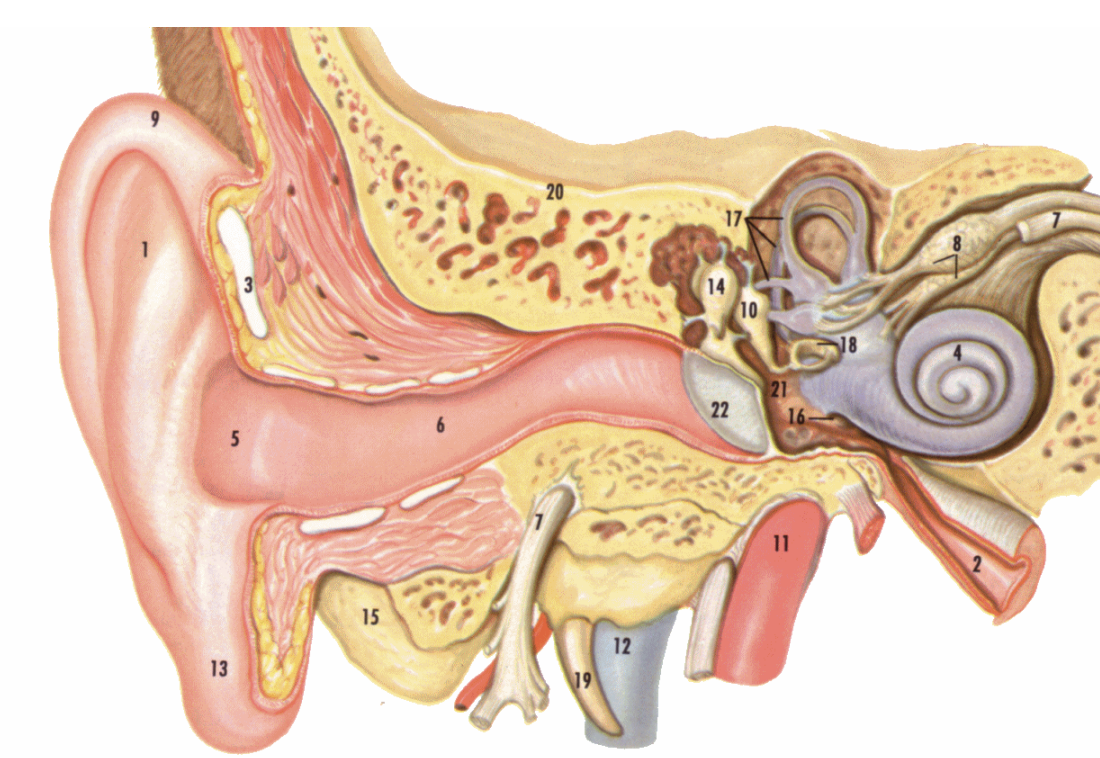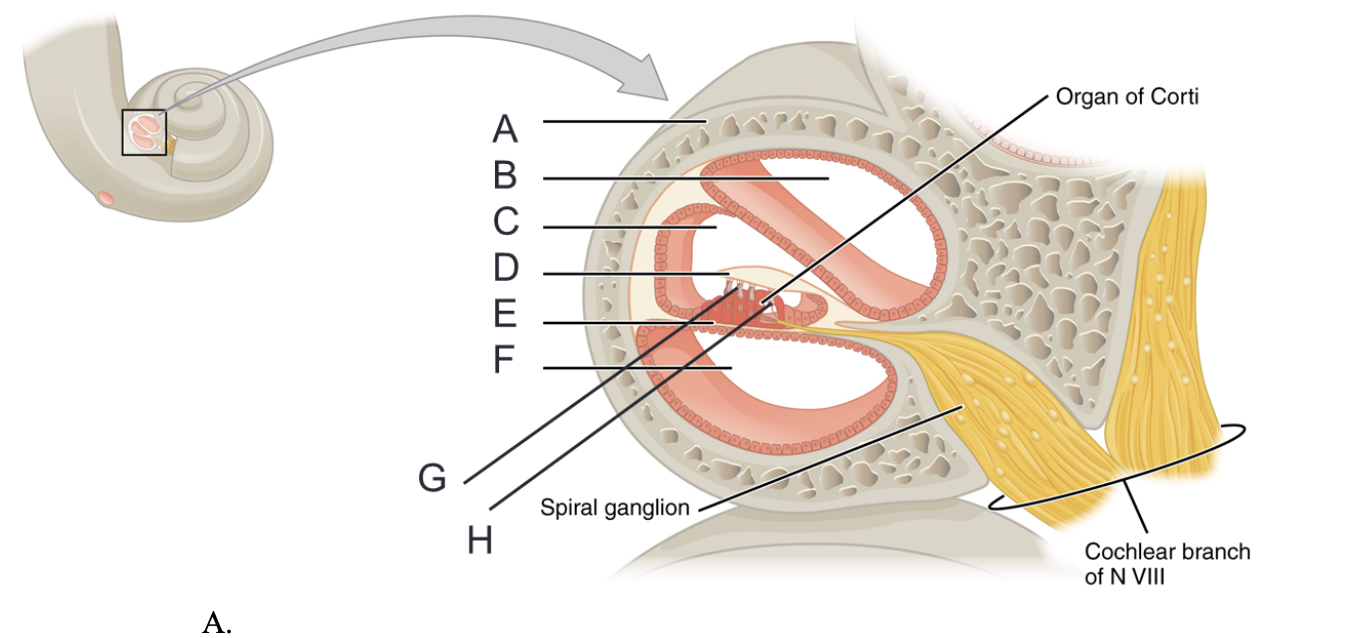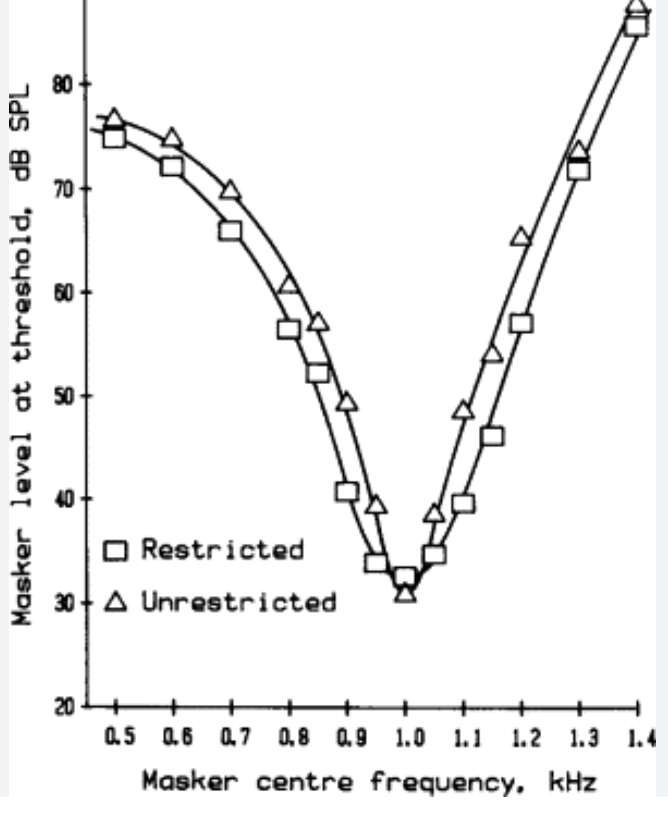Hearing Science Exam 2-- Quizzes
1/87
There's no tags or description
Looks like no tags are added yet.
Name | Mastery | Learn | Test | Matching | Spaced |
|---|
No study sessions yet.
88 Terms
functions of the outer ear
protects middle ear, amplify mid frequencies, differentiates sounds from front and behind, helps localize sound
Interaural Time Differences
most relevant at low frequencies
Interaural Level Differences
most relevant at high frequencies
Which of the following contributes to the acoustic gain provide by the outer ear?
Pinna Flange, Ear Canal, Concha, Head, Torso and Neck
In measuring head related transfer functions (HRTFs) for the two ears, the sound source (input) at 4000 Hz is 60 dB SPL. The sound level measured at the entrance to the left ear canal is 45 dB SPL. The dB gain value of the left-ear HRTF is:
15 dB
In measuring head related transfer functions (HRTFs) for the two ears, the sound source (input) at 4000 Hz is 60 dB SPL. The sound level measured at the entrance to the left ear canal is 45 dB SPL, and is 55 dB SPL at the entrance to the right ear. The interaural level difference at 4000 Hz is:
10 dB
Which of the three pathways for getting energy into the cochlea is most effective for normal hearing?
Ossicular chain vibration
Which of the middle-ear pressure amplification factors provides the most gain?
area transformer
Match the impedance factor with the most relevant frequency region
Low Frequencies: Stiffness
High Frequencies: Mass
Mid Frequencies: Damping
Which of the following is not a limit of the middle-ear acoustic reflex?
Only works to change the mass of the system
Identify whether these parts of the inner ear are part of the vestibular system, the auditory system, or both:
Vestibular System:
Saccule, Otolith Organs, Semicircular Canals
Auditory System:
Organ of Corti, Cochlea
Both:
Cranial Nerve VIII, Endolymph, Hair cells
Reissner's membrane
Separates the scala vestibuli from the scala media
Modiolus
The central axis around which the cochlear spiral winds
Basilar Membrane
Supports the organ of Corti
Organ of Corti
Contains the cochlear sensory hair cells
Helicotrema
The very apex of the cochlea
Hair cells
Sensory cells of the inner ear
Tectorial membrane
Gelatinous structure that sits atop the sensory hair cells
Which impedance factor varies along the basilar membrane and is the primary determinant of how resonant frequency changes along the length of the cochlea?
stiffness
scala media
Which scala contains the hairs (stereocilia) of the cochlear sensory cells?
Inner hair cells
which hair cells are closer to the modiolus
You observe that the motion of the basilar membrane is maximal 30 mm from the stapes. If the basilar membrane responds to frequencies over the range from 20 to 20000 Hz, which of the following tones was most likely the stimulating tone?
75 Hz
A particular stimulus causes three places of maximal displacement of basilar-membrane motion. What is most likely true about the stimulus?
It's a complex sound with three frequency components
The basilar membrane is _____ in the base of the cochlea compared to the apex, where the basilar membrane is _____.
narrower;wider
Which feature of the cochlea helps to establish its tonotopic (frequency-specific) organization?
Variations in basilar membrane stiffness
The basilar membrane is tonotopically organized, with low frequencies represented at the _____ and high frequencies represented at the _____.
apex,base
Because a traveling wave causes displacement at a range of locations on the basilar membrane, each location acts as a ______.
band pass filter
Inner hair cells are connected to the tectorial membrane and the basilar membrane, unlike the outer hair cells which are connected to the basilar membrane only.
false
Select all that apply to Type I afferent auditory neurons
comprise 95% of the auditory nerve, myelinated, innervate inner hair cells, larger
Select all that apply to Type II afferent auditory neurons
comprise 5% of the auditory nerve, smaller, unmyelinated, innervate outer hair cells
What motor protein changes configuration and causes outer hair cell length to change?
prestin
Which of the following structures helps to improve sound detection and frequency selectivity in the cochlea?
outer hair cells
Inner hair cells convey information to the brain via _____ neurons. Outer hair cells receive information from the brain via _____ neurons
afferent, efferent
match the independent-variable units with the neural response-plot type
Rate-Level function: dB SPL
Turning Curve: Hertz
Post-stimulus time histogram: milliseconds
Match the dependent variable units with the neural response plot type
Rate level function, post stimulus time, post stimulus time histogram:spike/second, turning curve: dB SPL
the full range of sound intensities can be coded by a single auditory nerve fiber
false
For which neural code is tonotopic organization most important?
place code
What is the limit of phase locking in a single auditory nerve fiber?
5000 Hz
Match each auditory nerve fiber threshold range to the associated spontaneous rate
Low rate: high threshold
medium rate: medium threshold
high rate: low threshold
Which of the following are advantages of having multiple auditory nerve fibers respond to the same sound signal, rather than relying on a single fiber?
Allows for representation of a wider range of sound intensities
improves the reliability of sound encoding
preserves information about sound frequency when individual fibers reach their firing limit
enables more precise timing information to be conveyed through phase locking across fibers
Which of the following characteristics of a neural threshold tuning curve changes with OHC loss?
Bandwidth, neural threshold
put the structures of the auditory pathway in order from bottom to top
cochlea, auditory nerve, cochlear nucleus, super olivary complex, lateral lemniscus, inferior colliculus, medial geniculate body, auditory cortex
which of the following structures are organized into a core region and a belt region
auditory cortex, medial geniculate body, inferior colliculus
which of the following structures makes the first place where information from both ears is combined
super olivary complex
match the 2 subdivisions of the SOC with their description
LSO: better at processing interaural level differences, has high frequency bias
MSO: better at processing interaural time differences, has low frequency bias
there is an ipsilateral bias along the auditory pathway
false
the belt regions of the upper brain structure are tonotopically organized
false
what is the first brainstem structure on which afferent AN fibers synapse
cochlear nucleus
match the region with the type of information it processes
auditory information: core regions of the upper brainstem structures
poly-sensory information: belt regions of the upper brainstem structures
computing resonance frequency
v= speed of sound (305/ length of canal m)
How are ILDs created, why are they most prevalent at high frequencies
differences in sound intensities arriving at 2 ears.Created by the acoustic shadow cast by the head. when sound hits the ear, it must travel around the head to get to the other ear. The head is the primary physical barrier w intensity reduction at the far ear. most prevalent at high frequencies because they have shorter wavelengths compared to head dimension.
calculating for interaural time differnence
ITD= distance (m) / speed of sound (350)
what is an HRTF (head related transfer function)
a measurement that describes how the outer ear, torso, and head transform a soundwave as it travels from sound source to eardrum. makes the brain able to localize sound. stimulates spatial hearing by filtering sounds for each ear.
3 mechanisms by which the ear provides pressure amplification
area transformer— main contributor to middle ear impedance mismatch (25 dB, x17)
lever transformer— lever action of middle ear bones (2 dB x1.3)
buckling motion— eardrum increases force transfer to malleus (6dB x2)
sequence of events when ear pops
after ascent, pressure decreases
eardrum is pushed outward
hearing is reduced
ear pops (swallow/yawn)= eustachian tube opening
hearing returns to normal
why do middle ear pathologies create low frequency hearing loss
the involve increased stiffness (creating low freq hearing loss)
what scala is connected to sapes through oval window
scala vestibuli
what scala is bordered by reissners membrane , organ of corti, and stria vascularis
scala media
what 2 scala are connected by helicotrema
scala vestibuli and scala tympani
what is meant by tonotopic representation
frequency sensitivity varies along the BM due to variations in resonance. spatial mapping of sound by frequency localization along the BM. maximal motion near base, low frequency at apex

label 16, 21, 2
oval window, stapes footplate, eustachian tube/ facial nerve

label D, E, F, G
tect. membrane, basilar membrane, scala tympani, OHC

label A,C,D,G,H,I,K,A
resissners membrane, tectorial membrane, spiral limbus, organ of corti, basilar membrane, spiral ligament, scala vascularis
what is the difference between DC and AC potential
DC— steady/non alternating, doesnt change with stimulus
AC— alternate at same frequency as sound stimulus , phase locked
where is endocochlear potential located, what is the normal resting rate
located in the scala media within the endolymph, resting potential is +80 mV maintained by the stra vascularis
what HCs have motile repsonses
OHCs have motile responses , fast motility is mediated by prestin
which hair cells send a majority of afferent messages to auditory nerve
IHCs
steps between stapes to neural impulses of ANF
sound travels thru air as a vibration
vibration reaches ear, tympanic membrane opens
ossicles vibrate, stapes footplate pushes in and out on oval window
fluid in cochlea moves, BM vibrates at frequency of the sound
HCs are depolarized w/ upward motion of BM
auditory nerve sends info about sound that was heard to CNS
ANF rate of discharge
not silent— they have spontaneous activity
low SR < 0.5 spikes
medium SR >0.5 to 18 spikes
high SR many up to 100 spikes
neural saturation
when a neuron has reached its maximal firing rate and cant increase its rate anymore
dynamic range vs spontaneous rate
inversely related—
high SR= low threshold, narrow range
low SR= high threshold, wide range

neural threshold turning curve
threshold for each frequency to make neuron respond , shows lowest threshold and where its most sensitive, typically V shaped
neural frequency response area
shows the firing rate of a neuron to many combinations of frequency and level
place code
freq of sound can be determined by noting which fiber fires the greatest relative discharge rate, place along BM and auditory nerve budle
temporal code
timing of AN discharges are used to determine frequency of input stimulus
volley theory
combining spikes across multiple fibers fills the temporal code , the time between spikes tells the brain about sound frequency
phase locking
ability to synchronize firing to a particular phase of a stimulus degrades above 5 kHz in ANFs. firing ANFs at a consistent phase of the stimulating sound waves cycle . for low freq sounds it can fire consistently and maintain timing w peaks of the sound wave. as freq increases, the cycles become too fast for the ANFs to fire a spike for every cycle
list components of central auditory system in order starting w auditory nerve
auditory nerve— sound from cochlea to brainstem
cochlear nucleus— processing
SOC (superior olivary cortex)— first binaural integration and localization
LL (lateral lemniscus)— temporal and spatial cues
IC (inferior colliculus)— first place for sensory info
MGB (medial geniculate body)— thalamic relay
auditory cortex— perceptual analysis and interpretation
core vs belt
core= direct input and precise tonotopy, simple info
belt= indirect input and broader frequency, complex
why are outer hair cells referred to as the “cochlear amplifier”
they help amplify low level sounds to increase sensitivity and sharpen tuning
which is an otoacoustic emission
DPOAE— 2 main types of OAEs : distortion produced (pure and continuous) and transient evoked (clicks)
what plot is used to measure threshold as a function of frequency
tuning curve, which illustrates auditory thresholds across varying frequencies.
a patient that has a middle ear pathology producing low frequency hearing loss would see an increase in what
stiffness
what mechanism does the ear canal use to help provide amplification
acoustic resonance — ear canal acts as a resonance tube to amplify sound pressure
what properties limits a single ANFs ability to encode intensity
limited dynamic range, spontaneous firing rate
what frequencies are most sensitive to ILDs
high frequencies
main function of inner hair cells
transduce signals from mechanical to electrical impulses
main function of outer hair cells
sensitivity and frequency selectivity